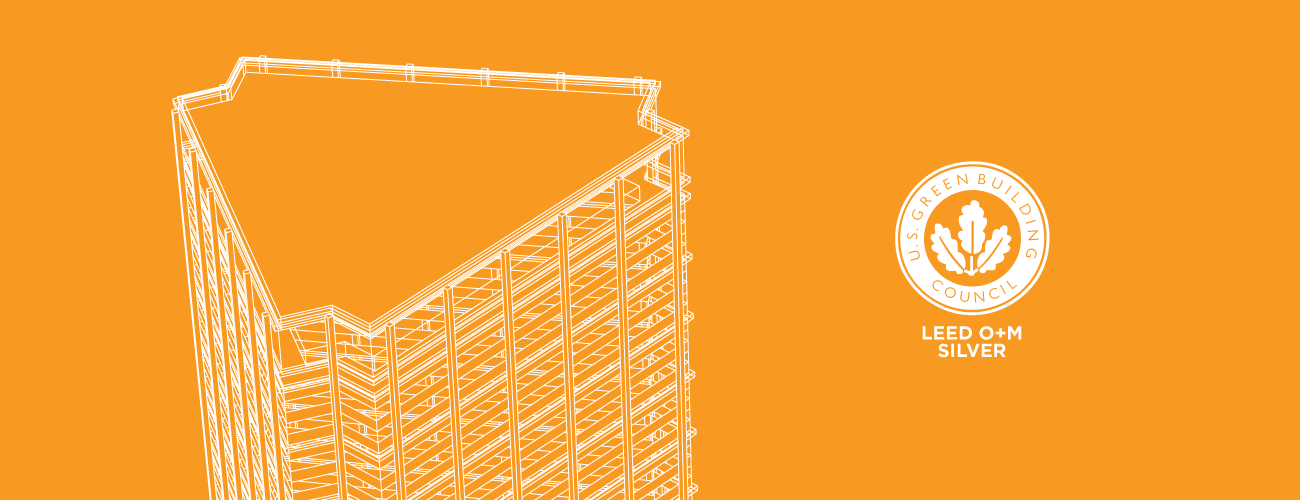U.S. Steel Tower
The U.S. Steel Tower has been an iconic fixture in Pittsburgh PA’s skyline for half a century, and its 64 stories make it the tallest building between the Philadelphia and Chicago. The office tower is managed by Winthrop Management, who has been working with evolveEA since 2013 to incrementally retrofit systems and improve operations. Thanks to years of investment by Winthrop and their tenants, the building is a leading partner in the Pittsburgh 2030 District, a program encouraging existing buildings to target a 50% reduction in energy use by the year 2030. The U.S. Steel Tower makes up 5% of Pittsburgh’s downtown office space in built square footage, and has repeatedly made headlines as improvements in its performance have led to a number of green building certifications.
When the U.S. Steel Tower was designed and built (1970), resource efficiency was not an expectation. But occupant health and resource conservation are key concerns for the Tower’s largest tenant, UPMC, and their goals present many synergies with Winthrop Management and other tenants. UPMC’s numerous LEED for Commerical Interiors Silver and Gold certifications comprise nearly half of the building’s leasable square footage, over one million square feet, and this has been instrumental in setting the tone for updating building standards and leveraging building improvements. After achieving BOMA 360 certification and three consecutive years of Energy Star certification (2016 – 2018), Winthrop worked with evolveEA to achieve a LEED V4 Silver Certification under the Operations + Maintenance (O+M): Existing Buildings rating system. One of the most unique aspects of this effort has been the Tenant Sustainability Committee created by Winthrop with help from evolveEA, which meets quarterly to collaborate on green initiatives for the whole building, with tenants and management leveraging each other’s efforts.
The U.S. Steel Tower LEED Silver O+M certification achieved in 2019 included:
- Location & Transportation: Support for alternative modes of transportation, including secure bicycle parking, electric vehicle charging stations, and ride share matching. Approximately 60% of the employees that work at the USS Tower commute using alternative modes of transportation.
- Sustainable Sites: Site management practices that reduce harmful chemical use, energy waste, water waste, air pollution, solid waste, and chemical runoff.
- Water Efficiency: Fixture and fitting upgrades, water sub-metering, increased cooling tower water cycles, and drip irrigation for the landscape. The USS Tower reduced building water consumption by 27% from 2016 to 2018.
- Energy & Atmosphere: Installation of highly efficient LEDs in the lobby and garage, installation of Variable Frequency Drives (VFDs), HVAC upgrades, and new energy-efficient elevator system, and existing building commissioning, resulting in Energy Star certification from 2016 to present.
- Materials & Resources: The building purchased sustainable products and increased the building’s recycling rate. Additionally, the sustainable purchasing and recycling practices associated with the four UPMC floors that are currently pursuing LEED for Commercial Interiors, contributed significantly in this category.
- Indoor Environmental Quality: Green cleaning practices, products, and equipment that improve human health, reduce impact on the environment, and provide a clean workspace for all tenants. Winthrop also performed a custodial effectiveness assessment, implements enhanced indoor air quality strategies, and practices green integrated pest management.
The O+M: Existing Buildings LEED Certification requires projects to recertify every five years (or as frequently as every year). This approach encourages cyclical improvements to the building’s environmental footprint, which Winthrop Management and their partners are well-positioned to take on for the long term. Their Tenant Sustainability Committee meets regularly, and ongoing engagement in the Pittsburgh 2030 District will continue to push the building’s performance toward increasingly ambitious targets for energy and water efficiency, indoor air quality, and low-impact transportation.


